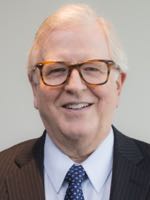
With Constitution Day (Sept. 17) approaching, News Media Alliance turned to the Newseum Institute’s First Amendment Center. The Newseum Institute is the programs and education partner of the Newseum, an interactive museum of news and journalism in Washington, D.C. The Newseum Institute includes the First Amendment Center, Religious Freedom Center, Newseum Education Department — all headquartered at the Newseum in D.C. — and three adjunct centers at Vanderbilt University, the University of Mississippi and the University of South Dakota.
Gene Policinski, chief operating officer at the Newseum Institute and senior vice president/executive director at the First Amendment Center, talked to News Media Alliance about the Constitution and more.
1. What drew you to working in news media?
I was curious even as a youngster about how government and politics and companies and “things” worked: how did decisions and choices get made. Being able to tell other people about that had an early attraction. As a 10-year-old, my parents reminded me later, I once sat next to our living room TV and “re-broadcast” the news of Election Night — having constructed my own “anchor desk” complete with campaign bumper stickers. A few years later, after being an editor for my high school newspaper, there was no other choice for me when headed to Ball State University. I took journalism classes my first year, got a paid internship job for the next summer at a small daily newspaper — and have worked every day since in various kinds of news media.
2. What is the most exciting thing go on at the First Amendment Center?
There is the thrill of leaving my office, going downstairs into the Newseum, and seeing the iconic items linked to First Amendment and Constitutional history you might be speaking or writing about — from the actual armbands worn by Mary Beth Tinker in the landmark student speech case, to letters and signs that helped shape major U.S. Supreme Court decisions on student speech and free speech for all, to seats from a Greensboro, N.C. lunch counter at which Civil Rights history was made, and much more.
3. What surprised you the most while working at the First Amendment Center?
Every day brings a new issue or question around our core freedoms (religion, speech, press, assembly and petition). … The First Amendment really is the “blue collar” amendment in the Constitution — going to work every day for people, who don’t have to worry about a knock on the door at home in the middle of the night because of what they texted from their phone at midday, or for those who don’t have to hide their religious beliefs for fear of being harassed by government, or for those who want to work for positive change in society but hold views that those in power don’t favor.
4. What is your favorite part of the Constitution? Why?
While I am at it, let’s choose which of my sons is my favorite! Granted, I am partial to the Bill of Rights — and more narrowly, the 45 words of the First Amendment. But the more you study the Constitution and the court decisions that interpret the application of the Constitution to real life, you see how interconnected it all is. Free speech, due process, the right to confront witnesses, protection against unreasonable search — all of those rights depend, in larger or smaller manner, on the others.
5. How do you see the future of news media?
The glib response is “dimly!” — like everybody else in an era of massive, quick change in they’re being honest. But that doesn’t convey the exciting sense of opportunity that comes along with working in a new tech and economic atmosphere where the way we deliver and consume news is open to innovation and which rewards creativity. People always will need to know news of the locality and the world around them. Increasingly they expect that to come in quicker, easier-to-digest, personalized deliveries — on the devices of their choice, but that’s just mechanics of delivery, not the essence of news.
Lest we forget, sizable portions of the news media have remained profitable — smaller to medium dailies and well-managed weeklies, and niche magazines, as examples — with some new media ventures showing signs of long-term financial security. Granted, major city print and TV double-digit profits and those legendary “gatekeeper” media empires, where news for the many was filtered through the hands of the relatively few, have faded and won’t return to dominance. But news media that provide accurate, timely core news and information targeted to their specific readers, viewers, listeners and users, will survive and ultimately thrive.
Follow @NewseumInst.

